And Now, The Soup
 Monday, January 2, 2012 at 3:48PM
Monday, January 2, 2012 at 3:48PM  Margot
Margot It doesn't really matter what kind of soup I am making. I make it the same way every time, and virtually in the same order, every time. And when it comes time to decide what to do with leftovers, I know that if I have stock in the freezer, I can have soup made in less than an hour. So, here are the basics to make any soup better, faster, cheaper.
The day before: Make the stock.
Or, if you are clever little white witch, you will already have it made and in the freezer. Take it out.
Chop the vegetables.
Unfortunately, I haven't found a gadget that makes this chore any faster. Food processors don't work, particularly when it comes to onions. So get yourself a good CHEFS knife and get chopping.
Most soup recipes will include onions, celery and garlic. Sometimes carrots, sometimes peppers. Those two tend to round out what is known as a mirapioux, or holy trinity, depending on where you are from. I start chopping my vegetables in this order:
Garlic
I mince my garlic with a press. I use a lot of it, and I want it to cook evenly and disperse throughout the dish. If you want to smash it, and mince it by hand with your knife, have at it.
Onions
Cut the onions down the length, with the root end and the top end being where your knife cuts through.
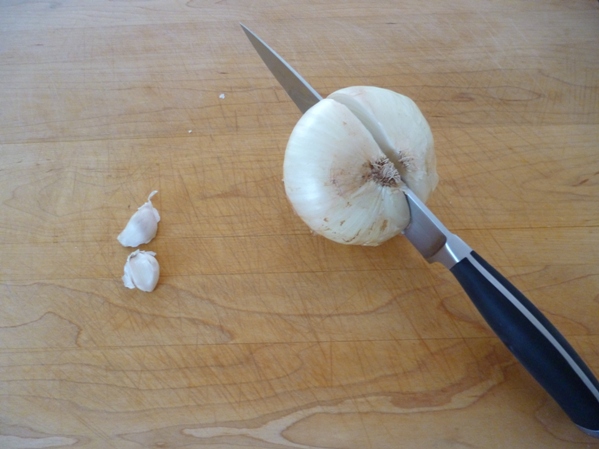
Then cut off the top end just enough to allow you to peel the onion skin back to where it will pull off at the root end.
Lay the onion down on it's flat side, and holding it down by the root end, take the tip of your knife and follow the natural layers of the onion, cutting down to the board.
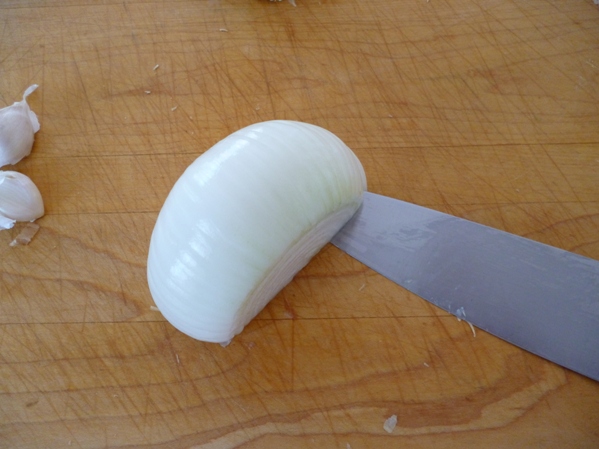
Keep cutting all around the sphere of the onion.
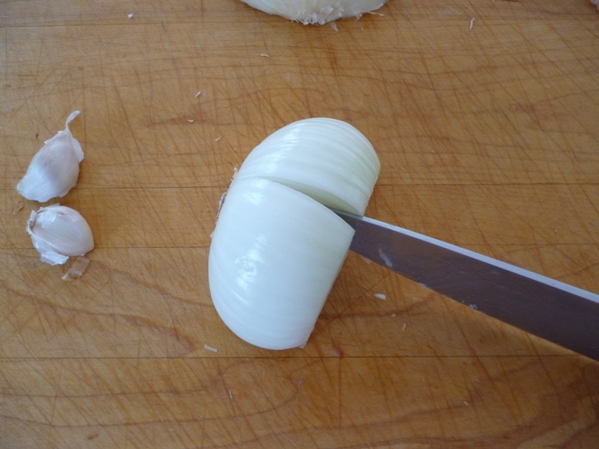
Now turn the onion and cut across the layers down to the board. Most TV chefs show you a secondary cut horizontally into the onion before making the final cut down. I have found there is no need to make this cut.
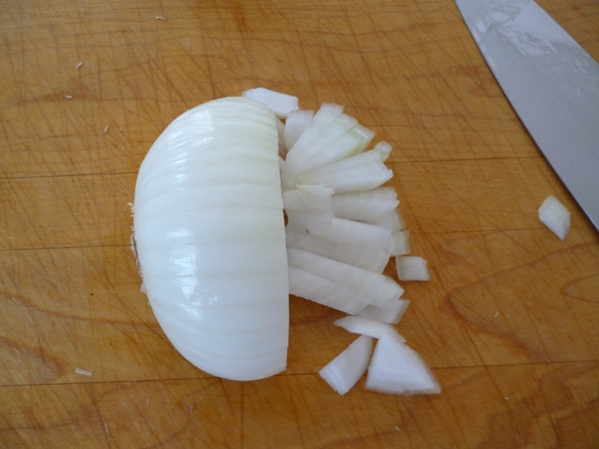
Once you get to the last 1/3 of the onion, turn it over onto the flat side again, and continue cutting until you are at the root end. You should end up with a onion, with a small dice.
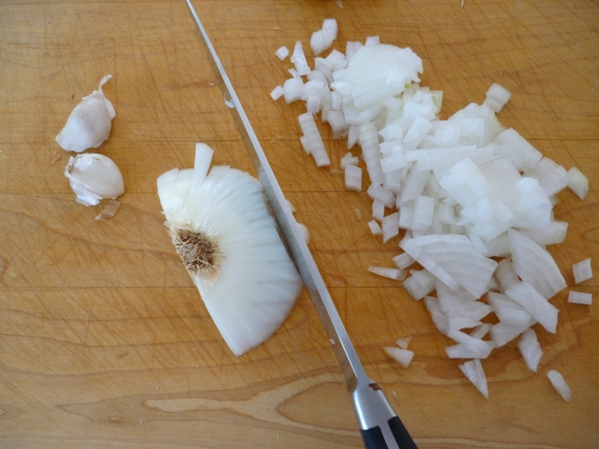
Celery
Wash the celery and cut off the root ends. Cut off the tops just below where it branches off. I use the middle hearts of the celery including the leaves, where it is very light green or yellow, for anything calling for raw celery. It is full of flavor and aroma. The outer leaves, on the other hand, are quite bitter, and I find them more suitable for cooking.
Cut the stalks in half again if you wish, then lay the stalk down on the round side, and using the tip of your knife, draw it from the root end all the want to the top end down to the board. This will give you two relative flat pieces of stalk.
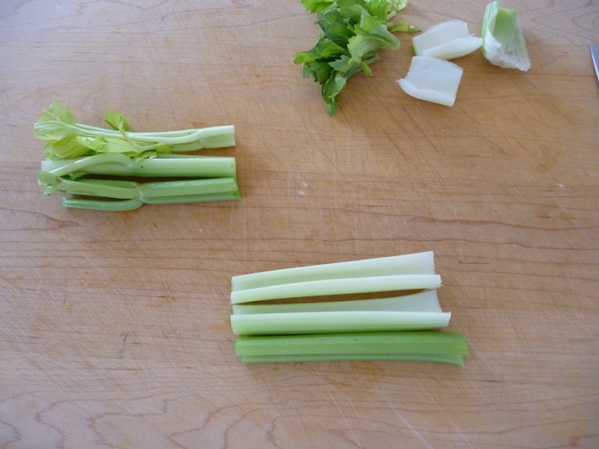
Use the tip of the knife again to cut each of those two pieces in two again.
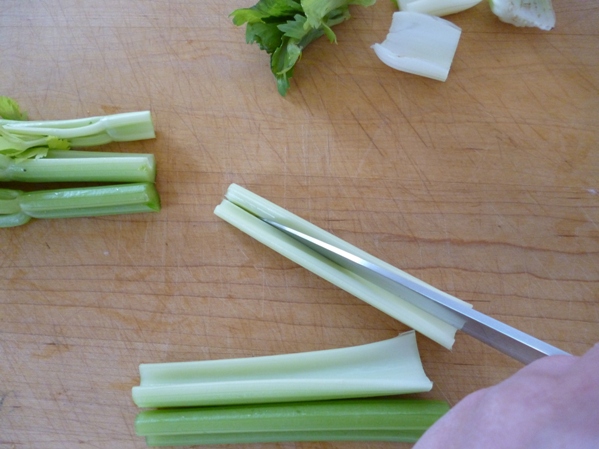
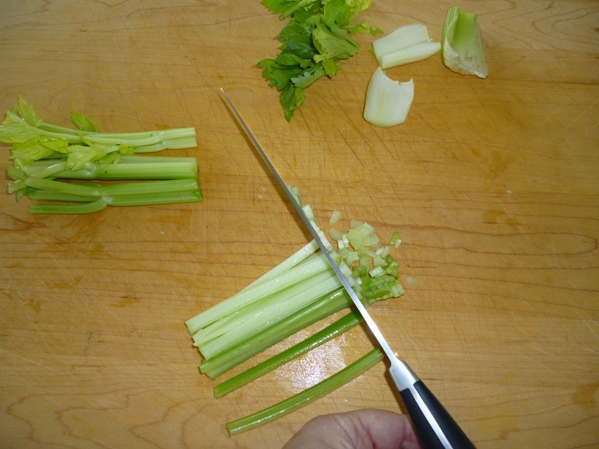
Now, holding as many of those fine stalks in a bundle as you can manage, finely dice them across the ends. You should end up with a very finely diced pile of celery.
Carrots
Dice the carrots the same as you did the celery. Place the carrot flat on the board and cut the end off. Leave the top end on. Lay your knife on top of the carrot lengthwise, and very carefully, press the entire knife down to the board. Lay each of those pieces flat on the board, and cut them lengthwise again.
Holding as many of those carrot stalks into a bundle as you can, cut them crosswise up to the root end. You should have a small diced carrot.
Peppers
Holding the pepper standing up, take the middle part of your chefs knife and cut straight down the side of the pepper. This will cut the part you want away from the center core. Continue with the other three sides.
Putting the pepper strips skin side down on the board, run the tip of the knife down the pepper strip, cutting each piece into two or three strips, depending on the size of the pepper.
Holding as many of these strips into a bundle as you can manage with one hand, cut crosswise until a dice. You should have a small diced pepper.
Start cooking your vegtables in fat
Whatever your recipe calls for, bacon, salt pork, butter, oils, get that into a large 6-7 quart dutch oven, over medium high heat.
While it is heating, bring the garlic and the onions close to your pan. When the fat just begins to smoke, put the garlic in the pan, and immediately stir it around evenly in the fat, until it just starts to color.
Immediately add your onions to the pan. Spread them around and get the garlic mixed it. You don't want to walk away from your garlic ever, as it burns very quickly.
Now, start your patience. The process of cooking these vegetables can take up to 30 minutes, depending on how dark you want your soup, and how much you are trying to cook at one time. Let the onions sit for at least 5 minutes without moving them. As you see the edges start to color, give them a good stir. Now wait another 5 minutes, and stir them again.
Now add the celery, stir it in, and give it five minutes. Stir again.
Now add the remaining vegetables, typically carrots or peppers. Carrots don't really need to saute, they will end up cooking in the broth. Peppers I like to get some color on, so let them saute a bit before going to the next step.
Season. Now.
With salt and pepper, and with whatever herbs or spices your recipe calls for. Allowing these flavors to saute in the fat cooking the vegetables is what will impart their flavor throughout the dish. They just need a minute or two.
Add the liquid.
Sometimes this is just stock, sometimes it will include canned tomatoes.
- If you are going to puree the vegetables to make a bisque, add the tomatoes, and only about 1 quart of the stock.
- If you are not doing a puree, add all but about 1 quart of your stock. Bring everything to a boil and cook until all of the vegetables are tender.
I use a boat motor to puree. I have found this the most useful tool in my kitchen, the easiest to use, and the easiest to clean up after. Worth the investment. At this stage, puree your vegetables until you have the consistancy called for in the recipe. Then add the remaining stock, leaving a quart or so at the end to adjust the consistancy if necessary. You can always add stock, but if your puree is too thin, you'll have to chop and cook more vegetables and that's not fun.
Thickening Methods:
If you are going to do any further thickening, this is the time to do it. Whether your recipe calls for cornstarch, a flour slurry, or a butter and flour roue this is the time to add it to the liquid.
Whatever the recipe calls for, I take the dry ingredient in a cup or bowl and slowing add the liquid ingredient, using a small spatula or wisk. If it's a rouge, it need not be cooked. Just mix one tablespoon soft butter with one tablespoon flour with your fingertips until you get a paste. If it's flour and water, add the water slowly and mix into a thick paste, then add more water to loosen it into a slurry. You will avoid lumps this way.
Let the soup get some body to it. Allow the thickening agents time to work. Keep it on a simmer for about 10 minutes. Taste and adjust your seasoning.
Add the Meat
I use mostly cooked meats for soup. Left over chicken, roast pork, sliced beef, all can be shredded and added at this point. You only need to heat them through.
So the next time you see a recipe for a soup you want to try, read through the ingredients and skip the part where it says, "add one can chicken stock."

Reader Comments